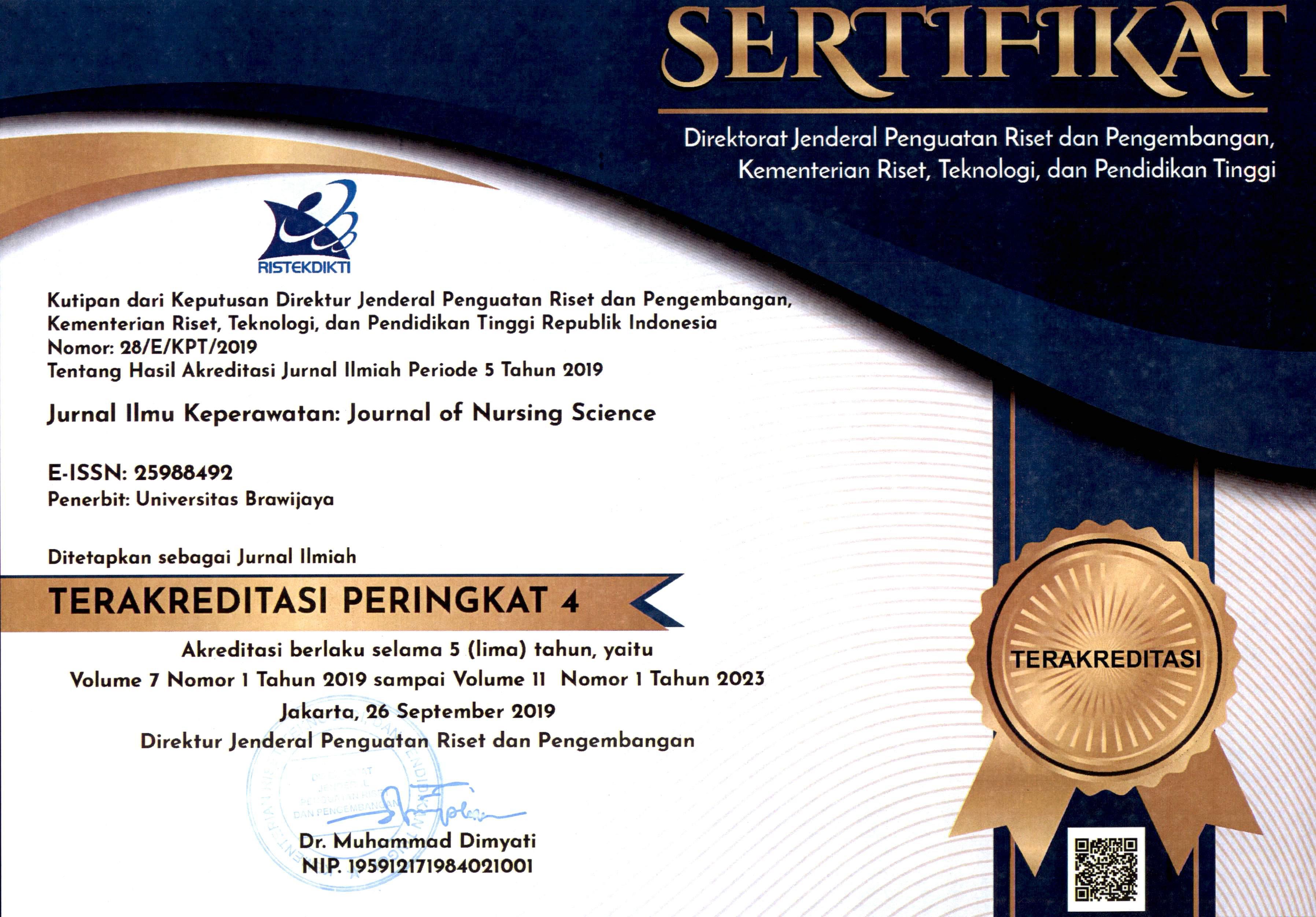Reducing Patients’ Death Rate Through Rapid Response Team Bell Activation in Emergency Room
DOI:
https://doi.org/10.21776/ub.jik.2022.010.01.8Keywords:
Death rate, Resuscitation, Emergency Room, BellAbstract
The patient death rate in the emergency department is a critical measure of the quality of hospital services and is regulated by legislation. The presence of a rapid response team is one of the factors influencing the fatality rate. A bell is a gadget that can summon a quick response team during the resuscitation process. The specific purpose of this research was to determine the effectiveness of the activation of the bell in the emergency room resuscitation of Universitas Airlangga Hospital on the patient death rate. The research design is a comparative study with a retrospective approach. Researchers used total sampling with a population of all patients in the emergency resuscitation room at Universitas Airlangga Hospital from July-December 2019 that met the criteria. The design of this study compared two groups that were extracted from the electronic register. The data were divided into two groups: three months before the intervention of the bell (N=62) and three months after the activation of the bell (N=65). The statistical analysis result of the Chi-Square Test obtained a p-value < 0.05 for the death rate between the two groups. There is a significant reduction in the death rate before and after the intervention. The result shows that it is possible to reduce the death rate by using a bell as a method to activate the rapid response team in the emergency room during resuscitation. This study offers a simple way to improve the death rate in the emergency room using bell intervention.
References
- Al-Omari, A., Al Mutair, A., & Aljamaan, F. (2019). Outcomes of rapid response team implementation in tertiary private hospitals: a prospective cohort study. International journal of emergency medicine, 12(1), 31. https://doi.org/10.1186/s12245-019-0248-5.
- Boniatti, M. M., Azzolini, N., Viana, M. V., Ribeiro, B. S., Coelho, R. S., Castilho, R. K., Guimarães, M. R., Zorzi, L., Schulz, L. F., & Filho, E. M. (2014). Delayed medical emergency team calls and associated outcomes. Critical care medicine, 42(1), 26–30. https://doi.org/10.1097/CCM.0b013e31829e53b9.
- Bullard, M. J., Musgrave, E., Warren, D., Unger, B., Skeldon, T., Grierson, R., van der Linde, E., & Swain, J. (2017). Revisions to the Canadian Emergency Department Triage and Acuity Scale (CTAS) Guidelines 2016. CJEM, 19(S2), S18–S27. https://doi.org/10.1017/cem.2017.365.
- Calder, L. A., Mastoras, G., Rahimpour, M., Sohmer, B., Weitzman, B., Cwinn, A. A., Hobin, T., & Parush, A. (2017). Team communication patterns in emergency resuscitation: A mixed methods qualitative analysis. International Journal of Emergency Medicine, 10(1), 24. https://doi.org/10.1186/s12245-017-0149-4.
- Chen, J., Ou, L., Hillman, K., Flabouris, A., Bellomo, R., Hollis, S. J., & Assareh, H. (2014). The impact of implementing a rapid response system: A comparison of cardiopulmonary arrests and mortality among four teaching hospitals in Australia. Resuscitation, 85(9), 1275–1281.
- https://doi.org/10.1016/j.resuscitation.2014.06.003.
- Di Somma, S., Paladino, L., Vaughan, L., Lalle, I., Magrini, L., & Magnanti, M. (2015). Overcrowding in emergency department: an international issue. Internal and Emergency Medicine, 10(2), 171–175. https://doi.org/10.1007/s11739-014-1154-8.
- Ding, Y., Park, E., Nagarajan, M., & Grafstein, E. (2019). Patient prioritization in emergency department triage systems: An empirical study of the Canadian Triage and Acuity Scale (CTAS). Manufacturing and Service Operations Management, 21(4), 723–741. https://doi.org/10.1287/msom.2018.0719.
- Hall, K. K., Lim, A., & Gale, B. (2020). The Use of Rapid Response Teams to Reduce Failure to Rescue Events: A Systematic Review. Journal of Patient Safety, 16(3S Suppl 1), 3–7. https://doi.org/10.1097/PTS.0000000000000748.
- Herod, R., Frost, S. A., Parr, M., Hillman, K., & Aneman, A. (2014). Long term trends in medical emergency team activations and outcomes. Resuscitation, 85(8), 1083–1087. https://doi.org/10.1016/j.resuscitation.2014.04.010.
- Kawaguchi, R., Nakada, T., Oshima, T., Abe, R., Matsumura, Y., & Oda, S. (2015). Reduction of unexpected serious adverse events after introducing medical emergency team. Acute Medicine & Surgery, 2(4), 244–249. https://doi.org/10.1002/ams2.101.
- Kementerian Sekretariat Negara Republik Indonesia. (2018). PP No. 24 Tahun 2018 tentang Pelayanan Perizinan Berusaha Terintegrasi Secara Elektronik. https://peraturan.bpk.go.id/Home/Details/82994/pp-no-24-tahun-2018.
- Limantara, R., Herjunianto, & Roosalina, A. (2013). Faktor-faktor yang Mempengaruhi Tingginya Angka Kematian di IGD Rumah Sakit. Jurnal Kedokteran Brawijaya, 28(2), 200–205. https://doi.org/10.21776/ub.jkb.2015.028.02.15.
- Lockey, A., Lin, Y., & Cheng, A. (2018). Impact of adult advanced cardiac life support course participation on patient outcomes—A systematic review and meta-analysis. Resuscitation, 129(May), 48–54. https://doi.org/10.1016/j.resuscitation.2018.05.034.
- Lyons, P. G., Edelson, D. P., & Churpek, M. M. (2018). Rapid response systems. Resuscitation, 128, 191–197. https://doi.org/10.1016/j.resuscitation.2018.05.013.
- Marshall, S. (2013). The use of cognitive aids during emergencies in anesthesia: A review of the literature. Anesthesia and Analgesia, 117(5), 1162–1171. https://doi.org/10.1213/ANE.0b013e31829c397b.
- Müller, M. P., Richter, T., Papkalla, N., Poenicke, C., Herkner, C., Osmers, A., … Heller, A. R. (2014). Effects of a mandatory basic life support training programme on the no-flow fraction during in-hospital cardiac resuscitation: An observational study. Resuscitation, 85(7), 874–878. https://doi.org/10.1016/j.resuscitation.2014.03.046.
- Setiarini, D., Kriswidyatomo, P., & Sari, G. M. (2019). Correlation between Patient ’ s Age and Advanced Response Time with Outcome of Cardio Pulmonary Resuscitation in Cardiac Arrest Patient, (02).
- Silva, R., Saraiva, M., Cardoso, T., & Aragão, I. C. (2016). Medical Emergency Team: How do we play when we stay? Characterization of MET actions at the scene. Scandinavian Journal of Trauma, Resuscitation and Emergency Medicine, 24(1), 1–6. https://doi.org/10.1186/s13049-016-0222-7.
- Sun, J. T., Chiang, W. C., Hsieh, M. J., Huang, E. P. C., Yang, W. S., Chien, Y. C., … Chen, L. W. (2018). The effect of the number and level of emergency medical technicians on patient outcomes following out of hospital cardiac arrest in Taipei. Resuscitation, 122(155), 48–53. https://doi.org/10.1016/j.resuscitation.2017.11.048.
- Vinet, L., & Zhedanov, A. (2010). A “missing” family of classical orthogonal polynomials. Nomor Tambahan Lembaran Negara Nomor 4355 Nomor Tambahan Lembaran Negara Nomor 4400, 1(5), 1–55. https://doi.org/10.1088/1751-8113/44/8/085201.
- Welch, S. J., Cheung, D. S., Apker, J., & Patterson, E. S. (2013). Strategies for improving communication in the emergency department: Mediums and messages in a noisy environment. Joint Commission Journal on Quality and Patient Safety, 39(6), 279–286. https://doi.org/10.1016/S1553-7250(13)39039-4.
- Yarmohammadian, M. H., Rezaei, F., Haghshenas, A., & Tavakoli, N. (2017). Overcrowding in emergency departments: A review of strategies to decrease future challenges. Journal of Research in Medical Sciences, 22(1). https://doi.org/10.4103/1735-1995.200277.
- Zachariasse, J. M., Van Der Hagen, V., Seiger, N., Mackway-Jones, K., Van Veen, M., & Moll, H. A. (2019). Performance of triage systems in emergency care: A systematic review and meta-analysis. BMJ Open, 9(5), 1–9. https://doi.org/10.1136/bmjopen-2018-026471.
- Zhu, A., Liu, X., & Zhang, J. (2021). Identifying a Clinical Risk Triage Score for Adult Emergency Department. Clinical Nursing Research, 30(8), 1135–1143. https://doi.org/10.1177/10547738211003273.
Downloads
Published
How to Cite
License
Copyright (c) 2022 Journal of Nursing Science Update

This work is licensed under a Creative Commons Attribution-NonCommercial 4.0 International License.
Authors published in this journal agree to the following terms:
1. The copyright of the received article shall be assigned to the journal as the publisher of the journal. The intended copyright includes the right to publish the article in various forms (including reprints). The journal maintains the publishing rights to the published articles.
2. Authors may enter into separate additional contractual agreements for the non-exclusive distribution of the published journal version of the work (for example, posting it to an institutional repository or publishing it in a book), with acknowledgment of their initial publication in this journal.
3. Authors are permitted and encouraged to post their work online (e.g. in an Institutional Repository or on their website) before and during the submission process, as this can result in a productive exchange, as well as earlier and larger citations of the published work.
4. Articles and all related material published are distributed under Creative Commons Attribution-NonCommercial 4.0 International License or CC BY-NC 4.0 license.
JNSU is licensed under a Creative Commons Attribution-NonCommercial 4.0 International License or CC BY-NC 4.0 license.






























